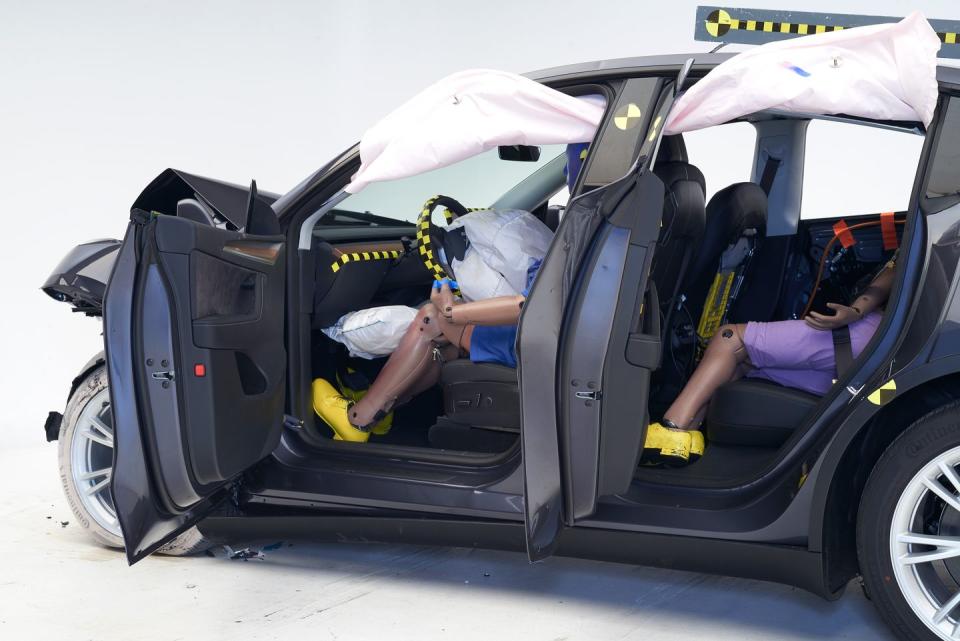SUV Passengers Aren’t as Safe as They Think, IIHS Says

SUV and crossover sales continue growing, as America's most popular models are marketed as the practical, safe option for families and new drivers alike.
However, crash test results from the Insurance Institute for Highway Safety show that rear seat occupants aren't actually that protected, even in modern midsize models.
Only four of the 13 SUVs and crossovers tested received good ratings, while six were rated poorly for high risk of head and neck injuries, including the iconic Jeep Wrangler.
Word-of-mouth wisdom says that SUVs and crossovers are inherently safer than your average Toyota Corolla. Having more steel, aluminum, and ride height between you and the impacting object is a surefire way to keep you and your occupants safe, right? At least, that's how the now pervasive body style has been marketed to families and new drivers since the turn of the century, but the Insurance Institute for Highway Safety (IIHS) says the facts aren't so cut and dried.
In fact, the rear seat passengers of SUVs and crossovers aren't all that safe, according to the most recent set of moderate overlap front crash tests. As new model-year midsize SUVs and crossovers are ushered in, the IIHS subjects them to a thorough set of crash tests. Particular emphasis is placed on often-fatal frontal crashes with the particularly violent moderate-overlap front test.
However, these tests usually focused on front seat occupants, meaning that rear seat safety remained unmeasured in frontal impacts. As a result, the IIHS updated its testing by adding an adult-size dummy to the rear seats in 2022, with a 12-year-old child-size dummy added this year. This update was spurred on by some worrisome statistics showing a 46% higher chance of fatality for belted rear seat occupants as compared to belted front seat occupants.
So, how did these family-favorite SUVs fare? Across a testing lineup of 13 models, only four received the highest IIHS rating of good. Ford's Mustang Mach-E was particularly impressive, receiving a good rating in every testing category, while the Ford Explorer followed closely behind with two score blemishes for mediocre rear seat restraints. Tesla's Model Y and the Subaru Ascent also received top ratings, with Tesla getting a single markdown for mediocre rear passenger restraints and Subaru receiving two points off for mediocre rear passenger restraints as well as a slight risk for head injuries.

In order to receive these good ratings, the IIHS measured sensors in the second-row dummy indicating injury to the head, neck, chest, abdomen, or thigh. Additionally, video footage and grease paint applied to the dummy's head is monitored to ensure the restraints prevented the head from hitting the vehicle interior or coming too close to the front seatback. Finally, testers make sure the dummy's body doesn't "submarine" or slide forward beneath the lap belt and cause abdominal injuries.
The Chevrolet Traverse, Volkswagen Atlas, and Toyota Highlander all received marginal ratings, which fall two positions below the highest rating of good. All three models struggle with a slight to high risk of head and neck injuries for rear seat passengers while the Traverse and Atlas exhibited seatbelts that were too tight and were liable to cause chest injuries in smaller adults and children. Toyota's Highlander was the highest scoring of the marginally rated three, but its rear seatbelts allowed for submarining and the resulting abdominal injuries.

The following six SUVs and crossovers received poor safety ratings overall due to severely lacking rear seat safety: Honda Pilot, Hyundai Palisade, Jeep Grand Cherokee, Jeep Wrangler 4-door, Mazda CX-9, and Nissan Murano. All of these models pose a high risk of head or neck injuries to the rear passenger, with the Wrangler's chassis construction and lack of a rear side-curtain airbag resulting in an even more significant risk of head or neck injuries.
The CX-9, Grand Cherokee, Palisade, and Pilot were also cited for seatbelts that were too tight. The Murano and Grand Cherokee also exhibited a high likelihood of head injuries from the front seatback and hard-plastic window area, though the Murano did receive the best marks of the group.
Ultimately, it is true that SUVs and crossovers provide exceptional front seat protection, as this entire lot received the highest markings in this category. But the IIHS says it is imperative that rear seat occupants are protected too, because these vehicles are marketed directly to families. Additionally, as pedestrian fatalities rise, it's important to remember that bigger, heavier vehicles like SUVs and crossovers require an additional level of responsibility behind the wheel.
"Zeroing in on weaknesses in rear seat safety is an opportunity to make big gains in a short time since solutions that are already proven to work in the front can successfully be adapted for the rear," said IIHS Senior Research Engineer Marcy Edwards, who led the development of the updated test. "The four good ratings in this round of testing show that some automakers are already doing it."
Do you take specific safety ratings into account when purchasing a vehicle? If so, which ones are important to you? Please share your thoughts below.

 Yahoo Autos
Yahoo Autos 